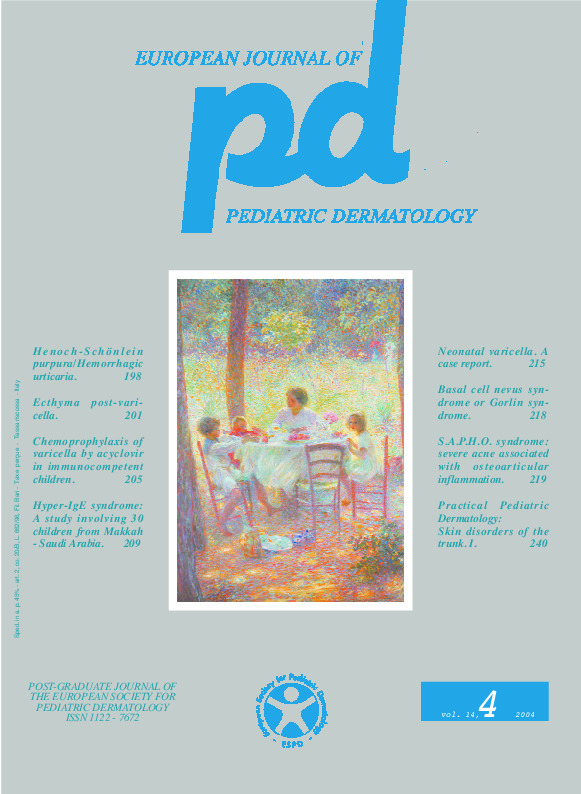Hyper-IgE syndrome. A study involving 30 children from Makkah - Saudi Arabia.
Downloads
How to Cite
Tonsi A. 2004. Hyper-IgE syndrome. A study involving 30 children from Makkah - Saudi Arabia. Eur. J. Pediat. Dermatol. 14 (4):209-14.
pp. 209-214
Abstract
The hyperimmunoglobulin E syndrome is a primary immunodeficiency state with elevated immunoglobulin E, eosinophilia, skin, skeletal and dental defects. The aim of this study was to determine the frequency of these abnormalities in children with Hyper IgE syndrome. This would enable in apprising clinicians of the importance of early recognition and management of this condition. This study was conducted at Alawi Tonsi Hospital, Makkah, Saudi-Arabia, from February 2001 to April 2004. We evaluated 30 human immunodeficiency virus-seronegative children from consanguineous -19- and non-consanguineous -11- families with hyperimmunoglobulin E syndrome. All the cases were new, aged 10 years or less and reported either directly to the dermatology outpatients or from other units of the same hospital. Their detailed histories were taken. Besides anthropometric measurements, physical and dental examinations were done and laboratory tests were performed. The classical findings of hyperimmunoglobulin E syndrome were put in evidence. 26 patients (86.66%) presented recurrent skin infections including bacterial, viral and fungal infections. 22 patients (73.33%) had respiratory tract infection with half of them suffering from bronchial asthma. 6 (20%) of the children had skeletal abnormalities such as scoliosis, repeated fractures and osteopenia. 16 (53.33%) children had dental abnormalities, while only 5 (16.66%) children had eye and 4 (13.33%) ear infections. Elevated serum immunoglobulin E levels were observed in 28 cases (93.33%), while hypereosinophilia was seen in 29 (96.66%) children. In conclusion, the hyperimmunoglobulin E syndrome is a multi-system immunodeficiency disorder involving cutaneous, skeletal, connective tissue, and dental abnormalities. This condition must be borne in mind when children with repeated skin and chest infections are encountered.Keywords
HyperIgE syndrome, Job’s syndrome, Immunoglobulin E

